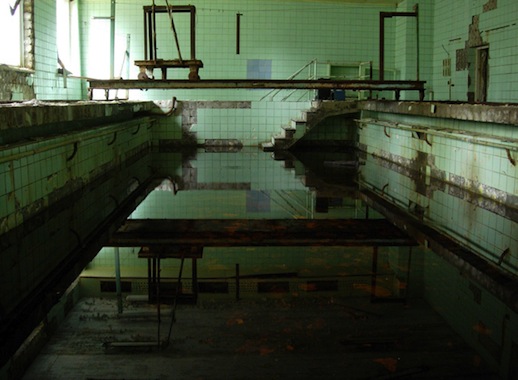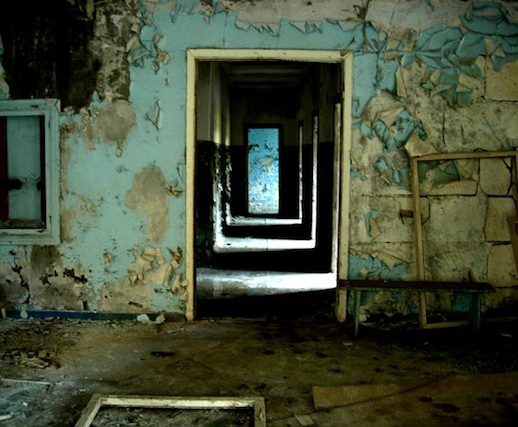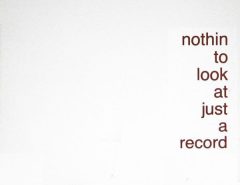
Seguiré con los post sobre la poética de los espacios en los que he hablado rápidamente de la arqueoacústica y he recopilado algunos trabajos sobre Chernobyl, entre los que se encuentra el trabajo de Peter Cusack llamado Sounds from dangerous places, presentado recientemente en arteleku con motivo del tercer Hirugarren Belarria. También he posteado algunos trabajos, grabaciones y publicaciones en este post sobre Fukushima como parte de esta serie sobre la poética de los espacios.
En esta cuarta entrega volveré a Chernobyl con los trabajos AION, una instalación sonora, y 4 ROOMS, un disco, del artista sonoro danés Jacob Kirkegaard. Ambas piezas están inspiradas en la famosa pieza I am sitting on a room de Alvin Lucier, disponible en ubuweb, y que es capaz de descubrir las resonancias de los espacios a través de este texto que explica a sí mismo (el proceso y el resultado):
I am sitting in a room different from the one you are in now. I am recording the sound of my speaking voice and I am going to play it back into the room again and again until the resonant frequencies of the room reinforce themselves so that any semblance of my speech, with perhaps the exception of rhythm, is destroyed. What you will hear, then, are the natural resonant frequencies of the room articulated by speech. I regard this activity not so much as a demonstration of a physical fact, but more as a way to smooth out any irregularities my speech might have.

Jacob usa este mismo procedimiento en las dos obras citadas anteriormente en distintas localizaciones de Chernobyl dándole voz a estos espacios, sin ánimo de hacer referencia a la estética cuarto-milenaria de Iker Jiménez. En esta entrevista, realizada con motivo de su participación en la exposición Soundings en el MOMA de Nueva York, el propio artista danés define su estancia allí como una experiencia mística y misteriosa:
I’ve been dreaming about it after, about going back there and being in this place again. “Mystical” is definitely the word — it’s not horrifying or it wasn’t sad or it wasn’t happy or super exciting. It was just very mystical, and the silence was so different, eerie. You listen and you know that there is something in the air. It makes you listen in another way; it makes you see other things. If you look at the trees, you see that the trees are radioactive. It just changes your perception of things.
Precisamente lo místico y lo misterioso hacen referencia a lo cerrado, arcano, oculto, secreto o reservado. Adjetivos que encajan perfectamente con estas dos obras, a través del propio procedimiento usado: grabar el espacio entendiéndolo como una serie de cajas cerradas en las que el sonido aparece a través del silencio. El propio lugar, una zona de exclusión, es en sí mismo una cerrazón entendida, por un lado, como una cualidad fonética en la que los órganos, al cerrarse, adquieren un sonido, y por otro como una niebla espesa, en inglés mist.
Esta idea de crear un resultado con el propio proceso, como en la obra de Alvin Lucier, me recuerda al libro de Carl Gustav Jung llamado Aion. Contribuciones al simbolismo del sí-mismo, haciendo referencia al título de la instalación:
It came from the whole time aspect that I think only occurred to me when I was there. I wanted to work with that time that exists in Chernobyl. I would definitely like to make a reference to our way of thinking, human beings of Europe, about time to understand things. To my understanding, “aion” doesn’t mean eternity; eternity doesn’t end. What I understood from this word is that it means just an immense amount of time; it stretches beyond our understanding. It’s a mystical time, pure and transcendental. That is what I think is interesting, because that is what radioactive time does.





Leave a Reply
Lo siento, debes estar conectado para publicar un comentario.